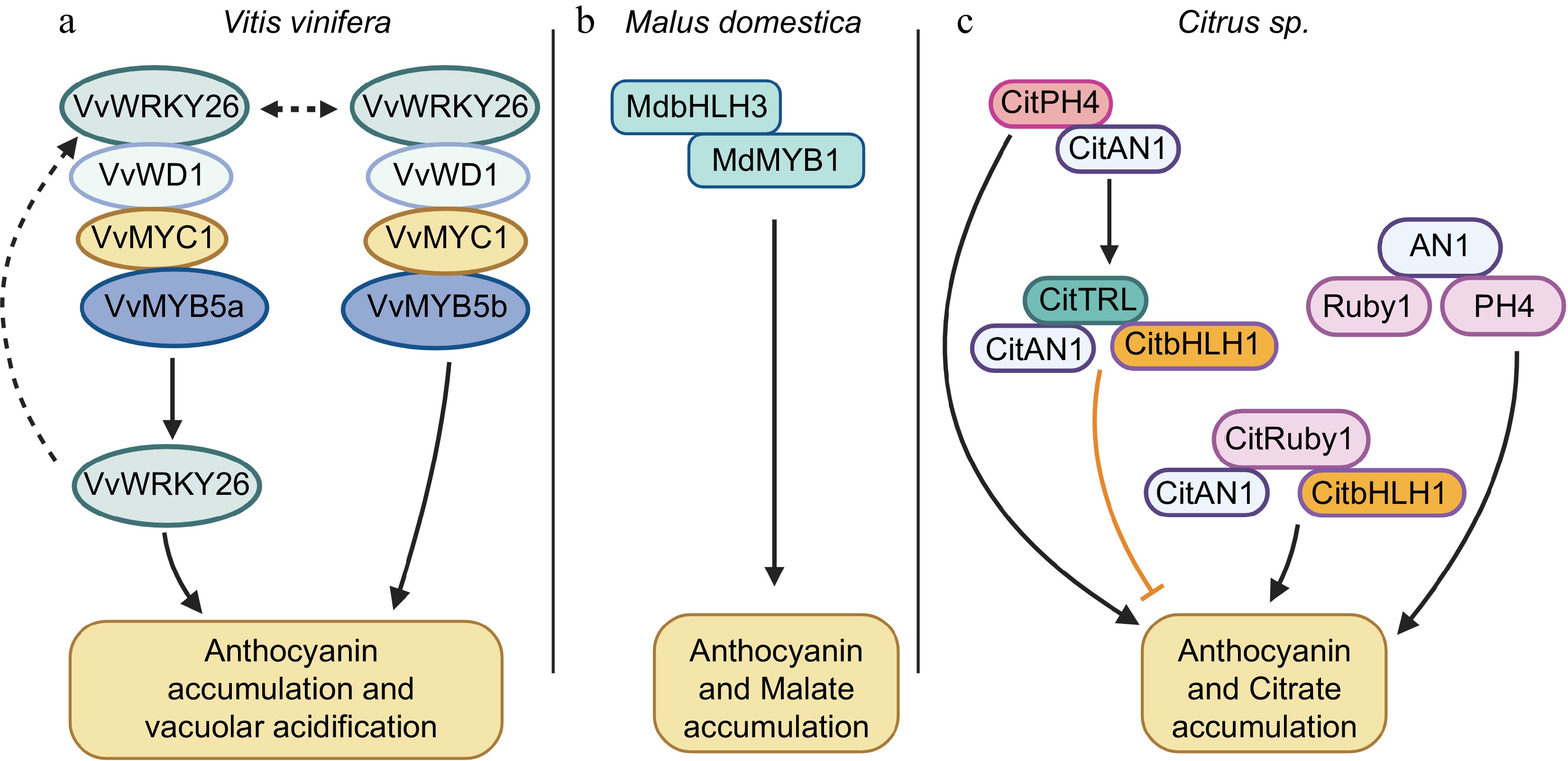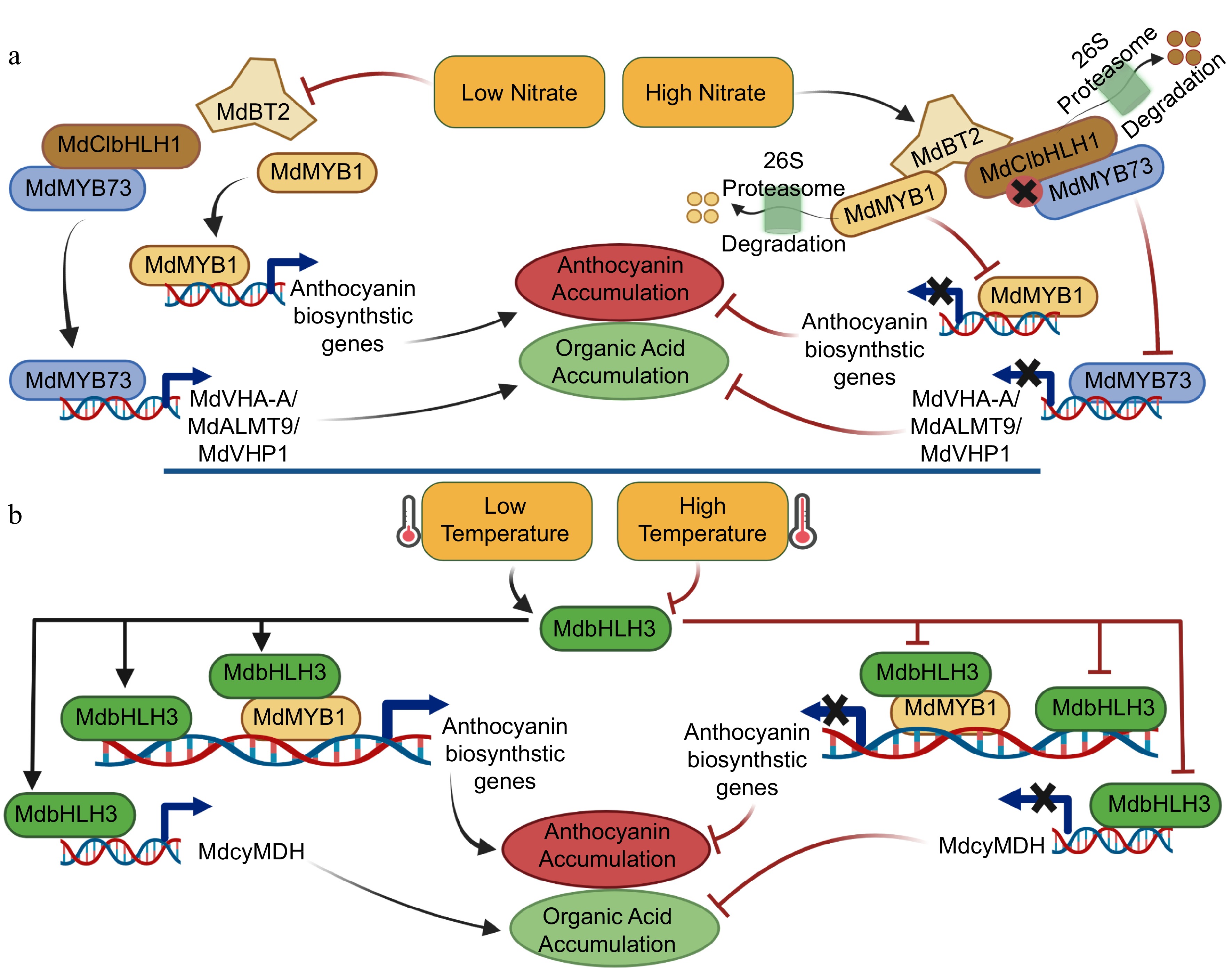-

Figure 1.
The morphological phenotypes of tissue-specific anthocyanin and organic acid accumulation of different fruits. Above: The phenotype differences between non-red-fleshed apple 'Jinshanyilamu' (left), a cultivar that accumulated less malate, and red-fleshed apple 'Yepingguo' (right), a cultivar that accumulated more malate[17]. Middle: 'LCA', a low citric acid pummelo cultivar (left) that is unable to produce anthocyanins, and 'HCA', a high citric acid pummelo cultivar (right) that is able to produce anthocyanins[30]. Below: Young leaves, flowers and seeds of 'Corsican Citron' (left) that has very low juice acidity around pH 5.5 and completely is unable to produce anthocyanins, and 'Poncire commun' (right) that has normal juice acidity around pH 2.5 and able to synthesize anthocyanins[18].
-

Figure 2.
Cooperation of TFs involved in co-regulation of anthocyanin and organic acid accumulation in fruit crops, including (a) grape (vitis vinifera), (b) apple (Malus domestica), and (c) citrus (Citrus sp.). Solid and dashed lines indicate proven and hypothetical (yet to be experimentally established) relationships, respectively. Arrows indicate positive regulators; T-bars indicate negative regulators.
-

Figure 3.
A simplified model of environmental co-regulation of anthocyanins and organic acids in apple fruit. (a) High nitrate cues trigger MdBT2 to ubiquitinates MdMYB1 and the MYB-bHLH complex, MdCIbHLH1-MdMYB73, which are involved in the regulation of anthocyanin biosynthesis and organic acid accumulation in apple fruit, respectively; Low nitrate cues inhibit MdBT2, thus, MdMYB1 and the MYB-bHLH complex, MdCIbHLH1-MdMYB73, enhances the accumulation of anthocyanin and organic acid in apple fruit. (b) High and low temperature cues inhibit and trigger the MYB-bHLH complex, MdMYB1-MdbHLH3, which is involved in the co-regulation processes of anthocyanin biosynthesis and organic acid accumulation, respectively.
-
Plant species TF family
classificationProtein name Negative/
positive regulatorFunctionality in trait regulation Reference Petunia (Petunia hybrida) MYB PH4 Positive Vacuolar acidification and flower color [45] Litchi (Litchi chinensis) LcMYB5 Positive Anthocyanin and malate accumulation [46] Citrus (Citrus spp.) CitTRL Negative Anthocyanin, PA and citric acid accumulation [47] Apple (Malus domestica) MdMYB1 Positive Anthocyanin and malate accumulation [17] Apple (Malus domestica) bHLH MdbHLH3 Positive Anthocyanin and malate accumulation [21,22] Citrus (Citrus spp.) CitAN1 Positive Anthocyanin and citric acid accumulation [34] Petunia (Petunia hybrida) AN1 Positive Vacuolar acidification and flower color [48] Grape (Vitis vinifera) WRKY VvWRKY26 Positive vacuolar acidification and flavonoid biosynthesis [49] Pear (Pyrus pyrifolia) PpWRKY44 Positive Anthocyanin and malate accumulation [35,36] Citrus (Citrus reticulata) ERF CitERF13 Positive Fruit color and citrate accumulation [50,51] Table 1.
Upstream regulators involved in the co-regulation of anthocyanin accumulation and acidity.
Figures
(3)
Tables
(1)